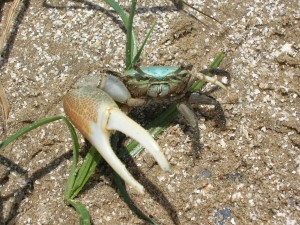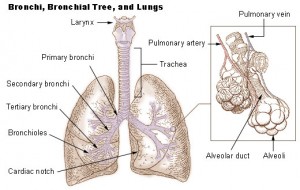It's All About Surface Area and Reproduction

You have a 50/50 Chance of Getting the Right Answer
Let's face it, as educators, parents, and adults we don't have answers to all the "whys" that come our way. However, I've found that there are two answers to almost any question in biology: sex and surface area (and is usually all boils down to just sex and reproductive success). I know this sounds funny, but if you remember this rubric, while leading guided hikes in the field, in class or teaching animal anatomy, you will always have a way to root out the answer you're looking for.
Sex, or reproduction, is the easiest of these two categories. If you think about it, almost all animal adaptations are geared towards keeping an an organism alive, fit, and able to pass on its genes. This could be the funky head penis of a land snail, the colorful feathers of a bird of paradise, the huge claw of fiddler crabs, or the crooning sounds of humpback whales. All organisms have adapted to survive, and to try to pass on their genes. Chances are, if you're studying a plant, animal, or insect, and you have a question about "I wonder why__________," that the answer may relate to something that increases the organism's reproductive fitness. Ultimately, almost all questions lead to sex and reproduction. With younger students, you may have to rephrase this as "adaptation" or "to help make more young" but the answer is still the same.

Surface area, the other 50% of this equation, is a bit harder to explain, but still just as important. Surface area is the reason that earthworms have rings, the lining of the lungs is branched, why animal intestines are so long, why frog skin is damp, and why you grind coffee. Earthworms have rings around their bodies (in part) because they breathe through their skin, and ridges allows more surface area for oxygen absorption than a flat surface.

Our lungs are filled with tiny sacs and branches, and our intestines are long and looped because of surface area. The more branching, looping, and whirling, the more surface area there is for oxygen or nutrient absorption. Frog skin is damp, because the water facilitates oxygen diffusion across their skin, and we grind coffee beans because the more we grind the beans, the more tiny surfaces that water can flow over, and the more flavor we get.

This list goes on and on. Granted, surface area adaptations are meant lead to increased fitness, which in turn increases reproductive success, so you're back to reproduction.
Regardless of the question, in biology, these two answers are building blocks for starting to find answers. I know it sounds funny, but for beginning biologists, naturalists, and those who are just curious about the world, this is a catchy way to remember where to start your inquiry.
Just for fun, here's a short quiz to see if you can guess if the answer to the question is for "reproduction" or "surface area" advantage. I've purposefully chosen very obscure questions, to see if you can parcel out where you could start to find the answers (I've supplied these answers at the end of the post, and don't cheat by just answering "reproduction"):
- There are ridges, called rugae, inside the lining of many mammals stomachs.
- Many plants bloom only at night, and instead of using visual cues, like showy flowers, they release pheromones to attract moths.
- Blue crabs have bristles or hairs all along the edges of their legs for smelling and sensing.
- Human, primate, and koala fingers have ridges or fingerprints.
- In some species of flies, the males have bottle brush shaped penises for removing competitor's sperm.
- The majority of the chloroplasts (photosynthetic cells) of a plant are located on the surface of leaves, and not the underside of the leaves.
- Cats have whiskers.
- Flies have compound eyes.
- Bighorn sheep grow larger and larger racks as they age and their bodies get larger.
- The final question is a video challenge question, still about surface area or reproduction, why does the manakin bird do this funky dance? (see video below) (This you've gotta see!)
Answers:
1. Surface area, 2. reproduction, 3. surface area, 4. surface area, 5. reproduction, 6. surface area, 7. surface area, 8. surface area, 9. reproduction, 10. reproduction.

